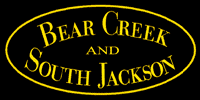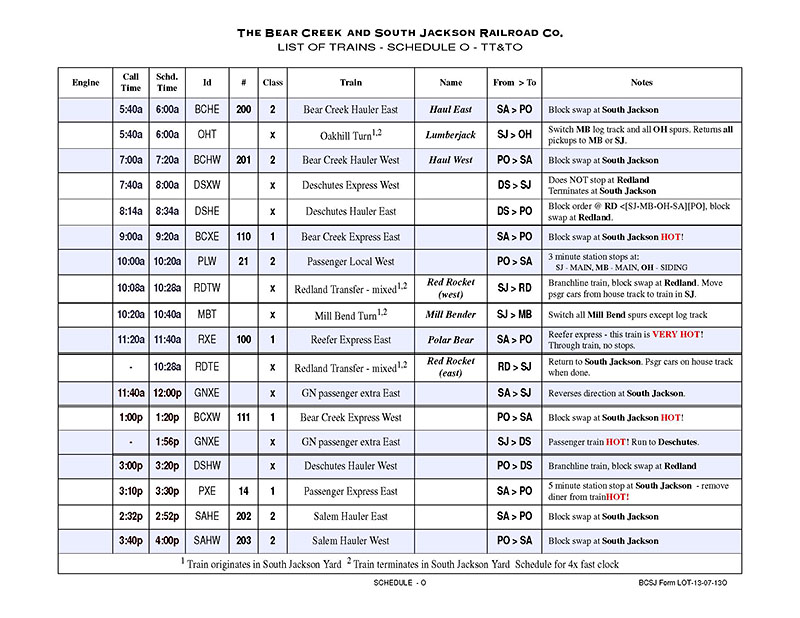 |
 |
 |
Time Table and Train Order Operation |
|
Opeating by Time Table and Train Orders
Time table and train order operation was developed long ago in the days when reliable communications between a dispatcher and trains were not possible. Through the use of a time table (schedule) and train orders, issued by a dispatcher, to modify the schedule when required train crews would be able to determine when they were authorized to be on specific pieces of track. The key to this process is knowing exactly what the time is. If train A knows that train B is not allowed to leave station ABC until 11:05 am and train A knows they can get to ABC from their current location by 11:00 (five minutes before train B can leave) then trains A's crew can head out on the main moving toward ABC secure in the knowledge that train B can't be heading towards them until 11:05. Assuming both trains have accurate knowledge of the time. |
||||||||
|
Classes of Trains Scheduled trains have classes which indicate priority. 1st class has the highest priority. Unscheduled trains (that do not appear in the timetable), called Extra trains, may also be present. All trains with a class are superior to extra trains (unless the dispatcher issues a train order stating otherwise).
Goto top |
||||||||
|
BC&SJ Form 19 Train Order Goto top |
||||||||
|
BC&SJ Form 31 Train Order Goto top |
||||||||
|
BC&SJ Generic Train Order Goto top |
||||||||
|
BC&SJ Clearance Card
Goto top |
||||||||
|
BC&SJ Simplified TT&TO Rulebook
Prototype railroad's rule books for TT&TO are big and complicated. They have to be to cover every possible circumstance over all permutations of signaled and dark, single and multiple tracks, etc. To expedite the learning process the BC&SJ used a simplified rulebook based on the 1952 Southern Pacific rulebook. From time to time as the crews become more familiar with the rules new rules and order types may be added.And if someone goofs and blows the rules no one is likely to get killed (depending on how much rolling stock bounces off the floor).
Rule S-71. Trains in the direction specified by the timetable are superior to trains of the same class in the opposite directions.
Rule 73.
Rule 81.
Rule 82.
Rule 82A.
Rule 83.
Rule 83-A.
Rule 85. Rule 87 (outside of block system limits). a) A regular train must be clear of main track before the leaving time of an opposing train of superior direction (SP 1952) b) A train must be clear of main track no less than five minutes before the leaving time of an opposing train of superior right or class (SP 1952). c) A train must be clear of main track before a superior first-class train or a train of superior right in the same direction is due to leave the next station in the rear where time is shown, but not less than ten minutes if schedule provides less than ten minutes time between the two stations. (SP 1952) Extra trains will be governed by train orders with respect to opposing extra trains. At a meeting point between extras or between work extras, the train in the inferior timetable direction must take the siding, unless other provided. Rule 89. When an inferior train fails to clear a superior train by the time required by rule, it must be protected at that time as prescribed by rule 99. Rule 89A. An inferior train must be in the clear with turnouts lined behind it no later than 5 minutes prior to the scheduled departure time of a superior opposing train. Within yard limits engines may use main track without train-order authority, clearing or protecting against first-class trains and without flag protection against second and inferior class trains, extra trains and engines.
Rule 95.
Rule 99
Rule 220.
|
||||||||
|
BC&SJ Train Line Up for TT&TO
The following trains comprise a tt&to op session on the BC&SJ as of July 2013. This table lists the trains in the sequence in which they are expected to leave their originating station (if all goes well). This list is a prize possession of the crew caller because it shows him what to expect. Normally a crew should be called 40 fast minutes (10 minutes) ahead of time so they can grab a throttle, paper work, and inspect their train.  |
||||||||
|
||||||||
BC&SJ Timetable |
||||||||
Train Registers |
||||||||
|
||||||||
|
||||||||
|
||||||||
Let's run a train! |
||||||||
|